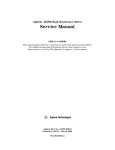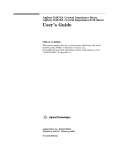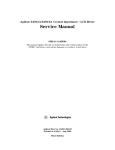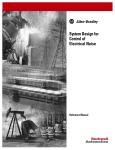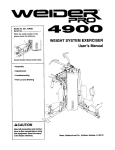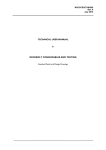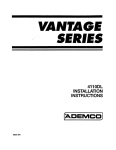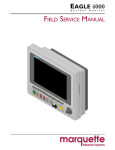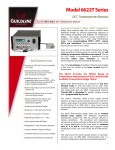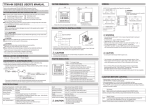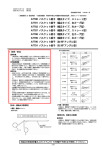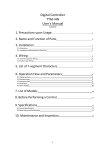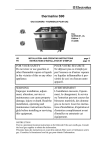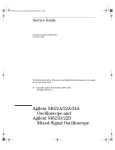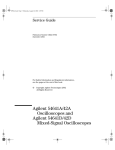Download HP 4349B Resistance Meter Service Manual
Transcript
Agilent 4349B 4-Channel High Resistance Meter Service Manual SERIAL NUMBERS This manual applies directly to instruments with serial number prex JP1KD. For additional important information about serial numbers, read \Instruments Covered by This Manual" in Chapter 1 of this manual. Agilent Part No. 04349-90033 Printed in JAPAN March 2001 Notice The information contained in this document is subject to change without notice. This document contains proprietary information that is protected by copyright. All rights are reserved. No part of this document may be photocopied, reproduced, or translated to another language without the prior written consent of the Agilent Technologies. Agilent Technologies Japan, Ltd. Component Test PGU-Kobe 1-3-2, Murotani, Nishi-ku, Kobe-shi, Hyogo, 651-2241 Japan c Copyright Agilent Technologies Japan, Ltd. 1996, 2000, 2001 Manual Printing History August 1996 : : : : : : : : : : : : : : : : : : : : : : : : : : : : : : : : : : : : : : : : : : First Edition (part number: 04349-90033) June 2000 : : : : : : : : : : : : : : : : : : : : : : : : : : : : : : : : : : : : : : : : : Second Edition (part number: 04349-90033) March 2001 : : : : : : : : : : : : : : : : : : : : : : : : : : : : : : : : : : : : : : : : : : Third Edition (part number: 04349-90033) iii Safety Summary The following general safety precautions must be observed during all phases of operation, service, and repair of this instrument. Failure to comply with these precautions or with specic WARNINGS elsewhere in this manual may impair the protection provided by the equipment. In addition it violates safety standards of design, manufacture, and intended use of the instrument. The Agilent Technologies assumes no liability for the customer's failure to comply with these requirements. Note 4349B complies with INSTALLATION CATEGORY II and POLLUTION DEGREE 2 in IEC1010-1. 4349B is INDOOR USE product. Ground The Instrument To avoid electric shock hazard, the instrument chassis and cabinet must be connected to a safety earth ground by the supplied power cable with earth blade. DO NOT Operate In An Explosive Atmosphere Do not operate the instrument in the presence of ammable gasses or fumes. Operation of any electrical instrument in such an environment constitutes a denite safety hazard. Keep Away From Live Circuits Operating personnel must not remove instrument covers. Component replacement and internal adjustments must be made by qualied maintenance personnel. Do not replace components with the power cable connected. Under certain conditions, dangerous voltages may exist even with the power cable removed. To avoid injuries, always disconnect power and discharge circuits before touching them. DO NOT Service Or Adjust Alone Do not attempt internal service or adjustment unless another person, capable of rendering rst aid and resuscitation, is present. DO NOT Substitute Parts Or Modify Instrument Because of the danger of introducing additional hazards, do not install substitute parts or perform unauthorized modications to the instrument. Return the instrument to a Agilent Technologies Sales and Service Oce for service and repair to ensure that safety features are maintained. Dangerous Procedure Warnings Warnings , such as the example below, precede potentially dangerous procedures throughout this manual. Instructions contained in the warnings must be followed. Warning iv Dangerous voltages, capable of causing death, are present in this instrument. Use extreme caution when handling, testing, and adjusting this instrument. Certication Agilent Technologies certies that this product met its published specications at the time of shipment from the factory. Agilent Technologies further certies that its calibration measurements are traceable to the United States National Institute of Standards and Technology, to the extent allowed by the Institution's calibration facility, or to the calibration facilities of other International Standards Organization members. Warranty This Agilent Technologies instrument product is warranted against defects in material and workmanship for a period of one year from the date of shipment, except that in the case of certain components listed in General Information of this manual, the warranty shall be for the specied period. During the warranty period, Agilent Technologies will, at its option, either repair or replace products that prove to be defective. For warranty service or repair, this product must be returned to a service facility designated by Agilent Technologies. Buyer shall prepay shipping charges to Agilent Technologies and Agilent Technologies shall pay shipping charges to return the product to Buyer. However, Buyer shall pay all shipping charges, duties, and taxes for products returned to Agilent Technologies from another country. Agilent Technologies warrants that its software and rmware designated by Agilent Technologies for use with an instrument will execute its programming instruction when property installed on that instrument. Agilent Technologies does not warrant that the operation of the instrument, or software, or rmware will be uninterrupted or error free. Limitation Of Warranty The foregoing warranty shall not apply to defects resulting from improper or inadequate maintenance by Buyer, Buyer-supplied software or interfacing, unauthorized modication or misuse, operation outside the environmental specications for the product, or improper site preparation or maintenance. No other warranty is expressed or implied. Agilent Technologies specically disclaims the implied warranties of merchantability and tness for a particular purpose. v Exclusive Remedies The remedies provided herein are buyer's sole and exclusive remedies. Agilent Technologies shall not be liable for any direct, indirect, special, incidental, or consequential damages, whether based on contract, tort, or any other legal theory. Assistance Product maintenance agreements and other customer assistance agreements are available for Agilent Technologies products. For any assistance, contact your nearest Agilent Technologies Sales and Service Oce. Addresses are provided at the back of this manual. vi Safety Symbols General denitions of safety symbols used on equipment or in manuals are listed below. Instruction manual symbol: the product is marked with this symbol when it is necessary for the user to refer to the instruction manual. Alternating current. Direct current. On (Supply). O (Supply). Frame or chassis terminal This Warning sign denotes a hazard. It calls attention to a procedure, practice, condition or the like, which, if not correctly performed or adhered to, could result in injury or death to personnel. This Caution sign denotes a hazard. It calls attention to a procedure, practice, condition or the like, which, if not correctly performed or adhered to, could result in damage to or destruction of part or all of the product. Note denotes important information. It calls attention to a procedure, practice, condition or the like, which is essential to highlight. vii Documentation Map Operation Manual Operation Manual (Agilent Part Number: 04349-90040 for English edition, 04349-97040 for Japanese edition) explains specications, basic measurement explanations, and how to verify conformance to published specications. Service Manual Service Manual (Agilent Part Number: 04349-90033) explains how to adjust, troubleshoot, and repair the 4349B. How To Use This Manual This is the Service Manual for the 4349B 4-Channel High Resistance Meter. This manual contains adjustments and repair information, and consists of the following four chapters. Chapter 1 General Information Chapter 1 gives general information for servicing the 4349B. This chapter lists the recommended equipment for adjustments and troubleshooting. Chapter 2 Adjustments Chapter 2 describes the adjustments, required to ensure that the 4349B is within its published specications after it has been repaired, or it fails the performance tests. Chapter 3 Assembly Replacement Chapter 3 provides the information on replacing the 4349B assemblies. The information includes replaceable assembly lists, and removal and installation procedures. Chapter 4 Troubleshooting Chapter 4 provides the information on troubleshooting the 4349B. The information includes theory of operation and information on faulty assembly isolation. Appendix A Manual Changes Appendix A contains manual changes and provides information for using this manual with 4349Bs manufactured before the printing date of the manual. Appendix B Default Jumper and Switch Settings Appendix B describes the settings of the jumpers and switches on the 4349B A2 CPU Board Assembly. The information is required when the A2 assembly is replaced. viii Contents 1. General Information Introduction . . . . . . . . . . . . . . . . . . . . . . . . . . . . . . . . . Instruments Covered by This Manual . . . . . . . . . . . . . . . . . . . . . Required Equipment . . . . . . . . . . . . . . . . . . . . . . . . . . . . . 1-1 1-1 1-2 2. Adjustments Introduction . . . . . . . . . . . . . . . . . . . . . . Safety Consideration . . . . . . . . . . . . . . . . . Required Equipment . . . . . . . . . . . . . . . . . . Adjustment Tools . . . . . . . . . . . . . . . . . . . Adjustable Components . . . . . . . . . . . . . . . . Factory-Selected Components . . . . . . . . . . . . . . EEPROM Write Protect Switch . . . . . . . . . . . . . Related Adjustments . . . . . . . . . . . . . . . . . . Adjustment Program . . . . . . . . . . . . . . . . . . Program Installation . . . . . . . . . . . . . . . . . Making a Working Copy . . . . . . . . . . . . . . Dening the Conguration . . . . . . . . . . . . . Program Execution . . . . . . . . . . . . . . . . . Adjustments Procedure References . . . . . . . . . . . DC Voltage Source (DC Power Supply or DCV Calibrator) Channel 1 Adjustment . . . . . . . . . . . . . . . . . Channel 1 Adjustment Using DC Power Supply . . . . Equipment . . . . . . . . . . . . . . . . . . . . Setup 1/2 . . . . . . . . . . . . . . . . . . . . . Setup 2/2 . . . . . . . . . . . . . . . . . . . . . Channel 1 Adjustment Using DCV Calibrator . . . . . . Equipment . . . . . . . . . . . . . . . . . . . . Setup 1/2 . . . . . . . . . . . . . . . . . . . . . Setup 2/2 . . . . . . . . . . . . . . . . . . . . . Channel 2, 3, and 4 Adjustments . . . . . . . . . . . . . . . . . . . . . . . . . . . . . . . . . . . . . . . . . . . . . . . . . . . . . . . . . . . . . . . . . . . . . . . . . . . . . . . . . . . . . . . . . . . . . . . . . . . . . . . . . . . . . . . . . . . . . . . . . . . . . . . . . . . . . . . . . . . . . . . . . . . . . . . . . . . . . . . . . . . . . . . . . . . . . . . . . . . . . . . . . . . . . . . . . . . . . . . . . . . . . . . . . . . . . . . . . . . . . . . . . . . . . . . . . . . . . . . . . . . . . . . . . . . . . . . . . . . . . . . . . . . . . . . . . . . . . . . . . . . . . . . 2-1 2-1 2-1 2-2 2-2 2-2 2-2 2-2 2-3 2-4 2-4 2-4 2-5 2-6 2-6 2-7 2-7 2-7 2-8 2-9 2-10 2-10 2-10 2-11 2-11 3. Assembly Replacement Introduction . . . . . . . . . . . . . Ordering Information . . . . . . . . Restored Exchange Assemblies . . . . Replacing the A2 CPU Board Assembly Replaceable Assembly List . . . . . . Replaceable Mechanical Parts List . . . Disassembly Procedures . . . . . . . Tools and Fasteners . . . . . . . . Cover Removal . . . . . . . . . . A1 Main Board Removal . . . . . . Removal Procedure . . . . . . . A2 CPU Board Assembly Removal . Removal Procedure . . . . . . . . . . . . . . . . . . . . . . . . . . . . . . . . . . . . . . . . . . . . . . . . . . . . . . . . . . . . . . . . . . . . . . . . . . . . . . . . . . . . . . . . . . . . . . . . . . . . . . . . . . . . . . . . . . . . . . . . . . . . . . . . . . . . . . . . . . . . . . . . . . . . . . 3-1 3-1 3-1 3-2 3-2 3-5 3-9 3-9 3-9 3-10 3-10 3-10 3-10 . . . . . . . . . . . . . . . . . . . . . . . . . . . . . . . . . . . . . . . . . . . . . . . . . . . . . . . . . . . . . . . . . . . . . . . . . . . . . . . . . . . . . . . . . . . . . . . . . . . . . . . . . . . . . . . . . . . . . Contents-1 A5 AC Inlet Board Assembly Removal Removal Procedure . . . . . . . Keyboard Assembly Removal . . . . Removal Procedure . . . . . . . LCD Assembly Removal . . . . . . Removal Procedure . . . . . . . Triaxial Connector Removal . . . . Removal Procedure . . . . . . . . . . . . . . . . . . . . . . . . . . . . . . . . . . . . . . . . . . . . . . . . . . . . . . . . . . . . . . . . . . . . . . . . . . . . . . . . . . . . . . . . . . . . . . . . . . . . . . . . . . . . . . . . . . . . . . . . . . . . . . . . . . . . . . . . . . . . . . . . . . . . . . . . . . . . . . . . . . . . . . . 3-10 3-10 3-10 3-10 3-11 3-11 3-12 3-12 4. Troubleshooting Introduction . . . . . . . . . . . . . . . . . . . . . Safety Considerations . . . . . . . . . . . . . . . Required Equipment . . . . . . . . . . . . . . . . . After Service Product Safety Checks . . . . . . . . . Theory of Operation . . . . . . . . . . . . . . . . . Overall Measurement Theory . . . . . . . . . . . . Overall Block Diagram . . . . . . . . . . . . . . . Analog Section . . . . . . . . . . . . . . . . . . I-V Converter . . . . . . . . . . . . . . . . . . Digital Section . . . . . . . . . . . . . . . . . . . Power Supply Section . . . . . . . . . . . . . . . Troubleshooting . . . . . . . . . . . . . . . . . . . Check Procedure References . . . . . . . . . . . . Check 1, DC-DC Converter Output Voltage . . . . Check 2, LCD Displays Anything? . . . . . . . . . Check 3, LCD Operates Correctly? . . . . . . . . Check 4, Any Error Message on LCD? . . . . . . . Check 5, CPU Related Error Message? . . . . . . . Check 6, CPU Power LED Lights? . . . . . . . . . Check 7, Any Error Code on LED? . . . . . . . . Check 8, CPU Fuse High Lead Voltage . . . . . . . Check 9, Fuse and Line Switch . . . . . . . . . . Check 10, DC-DC Converter Input Voltage . . . . . Check 11, DC-DC Converter Open Output Voltages . Check 12, Transformer Secondary Voltage . . . . . . . . . . . . . . . . . . . . . . . . . . . . . . . . . . . . . . . . . . . . . . . . . . . . . . . . . . . . . . . . . . . . . . . . . . . . . . . . . . . . . . . . . . . . . . . . . . . . . . . . . . . . . . . . . . . . . . . . . . . . . . . . . . . . . . . . . . . . . . . . . . . . . . . . . . . . . . . . . . . . . . . . . . . . . . . . . . . . . . . . . . . . . . . . . . . . . . . . . . . . . . . . . . . . . . . . . . . . . . . . . . . . . . . . . . . . . . . . . . . . . . . . . . . . . . . . . . . . . . . . . . . . . . . . . . . . . . . . . . . . . . . . . . . . . . . . . . . . . . . . . 4-1 4-1 4-1 4-2 4-3 4-3 4-4 4-4 4-6 4-7 4-8 4-9 4-11 4-11 4-12 4-12 4-12 4-12 4-12 4-13 4-14 4-14 4-15 4-16 4-17 A. Manual Changes Introduction . . . . . . . . . . . . . . . . . . . . . . . . . . . . . . . . . Manual Changes . . . . . . . . . . . . . . . . . . . . . . . . . . . . . . . A-1 A-1 B. Default Jumper and Switch Settings Introduction . . . . . . . . . . . . . . . . . . . . . . . . . . . . . . . . . Jumper and Switch Settings . . . . . . . . . . . . . . . . . . . . . . . . . B-1 B-1 Index Contents-2 Figures 1-1. 2-1. 2-2. 2-3. 2-4. 2-5. 3-1. 3-2. 4-1. 4-2. 4-3. 4-4. 4-5. 4-6. 4-7. 4-8. 4-9. 4-10. 4-11. 4-12. 4-13. B-1. Serial Number Label . . . . . . . . . . . . . . . . . . Adjustment Program Flow . . . . . . . . . . . . . . . Channel 1 Adjustment, Setup 1/2 (using DC Power Supply) Channel 1 Adjustment, Setup 2/2 (using DC Power Supply) Channel 1 Adjustment, Setup 1/2 (using DCV Calibrator) . Channel 1 Adjustment, Setup 2/2 (using DCV Calibrator) . Cover Removal . . . . . . . . . . . . . . . . . . . . Cable Assembly Connection for Triaxial Connector . . . . Ohm's Law . . . . . . . . . . . . . . . . . . . . . . 4349B Overall Block Diagram . . . . . . . . . . . . . . Analog Section Block Diagram . . . . . . . . . . . . . I-V Converter Block Diagram . . . . . . . . . . . . . . Digital Section Block Diagram . . . . . . . . . . . . . Power Supply Section Block Diagram . . . . . . . . . . Troubleshooting Flow . . . . . . . . . . . . . . . . . DC-DC Converter Output Voltage Check . . . . . . . . . CPU Board Assembly LED Light Sequence . . . . . . . . Location of High Lead of A2F1 Fuse . . . . . . . . . . Test Pin Locations . . . . . . . . . . . . . . . . . . . DC-DC Converter Output Connector . . . . . . . . . . Transformer Secondary Voltage Check . . . . . . . . . Jumper and Switch Settings . . . . . . . . . . . . . . . . . . . . . . . . . . . . . . . . . . . . . . . . . . . . . . . . . . . . . . . . . . . . . . . . . . . . . . . . . . . . . . . . . . . . . . . . . . . . . . . . . . . . . . . . . . . . . . . . . . . . . . . . . . . . . . . . . . . . . . . . . . . . . . . . . . . . . . . . . . . . . . . . . . . . . . . . . . . . . . . . . . . . . . . . . . . . . . . . . . . . . . . . . . . . . . . . . . . . . . . . . . . . . . . . . . . . . . . . . . 1-1 2-3 2-8 2-9 2-10 2-11 3-9 3-12 4-3 4-4 4-5 4-6 4-7 4-8 4-10 4-11 4-13 4-14 4-15 4-16 4-17 B-1 . . . . . . . . . . . . . . . . . . . . . . . . . . . . . . . . . . . . . . . . . . . . . . . . . . . . . . . . . . . . . . . . . . . . . . . . . . . . . . . . . . . . . . . . . . . . . . . . . . . . . . . . . . . . . . . . . . . . . . . . . . . . . . . . . . . . . . . . . . . . 1-2 1-2 1-2 2-2 3-3 3-4 3-4 3-5 3-6 3-7 3-8 4-11 4-16 A-1 Tables 1-1. 1-2. 1-3. 2-1. 3-1. 3-2. 3-3. 3-4. 3-5. 3-6. 3-7. 4-1. 4-2. A-1. Required Equipment . . . . . . . . . . . . . . . Required Language Extensions . . . . . . . . . . Substitute Equipment . . . . . . . . . . . . . . Related Adjustments . . . . . . . . . . . . . . . Replaceable Major Assembly List . . . . . . . . . A2 CPU Board Assembly, Replaceable Assembly List Replaceable Assembly List . . . . . . . . . . . . Replaceable Mechanical Parts List 1 . . . . . . . . Replaceable Mechanical Parts List 2 . . . . . . . . Replaceable Mechanical Parts List 3 . . . . . . . . Replaceable Mechanical Parts List 4 . . . . . . . . DC-DC Converter Output Voltages (Connected) . . DC-DC Converter Open Output Voltages . . . . . . Manual Changes by Serial Number . . . . . . . . . . . . . . . . . . . . . . . . . . . . . . . . . . . . . . . . . . . . . . . . . . Contents-3 1 General Information Introduction This chapter provides information on instruments covered by this manual and required equipment for adjustments and troubleshooting. Instruments Covered by This Manual Agilent Technologies uses a two-section, nine character serial number which is printed on the serial number label (Figure 1-1) attached to the instrument's rear panel. The rst ve characters are the serial prex, and the last ve digits are the sux. Figure 1-1. Serial Number Label An instrument manufactured after the printing date of this manual may have a serial number prex that is not listed on the title page. This unlisted serial number prex indicates the instrument is dierent from those described in this manual. The manual for this new instrument may be accompanied by a yellow Manual Changes supplement or have a dierent manual part number. This sheet contains \change information" that explains how to adapt the manual to the newer instrument. In addition to change information, the supplement may contain information for correcting errors (Errata) in the manual. To keep this manual as current and accurate as possible, Agilent Technologies recommends that you periodically request the latest Manual Changes supplement. The supplement for this manual is identied by this manual's printing date and its part number, both of which appear on the manual's title page. Complimentary copies of the supplement are available from Agilent Technologies. If the serial prex or number of an instrument is lower than that on the title page of this manual, see Appendix A, Manual Changes . For information concerning, a serial number prex that is not listed on the title page or in the Manual Change supplement, contact the nearest Agilent Technologies oce. General Information 1-1 Required Equipment Table 1-1 lists the required equipment for adjusting and troubleshooting the 4349B. Table 1-2 lists the required language extensions to be used with the adjustment program. Table 1-3 lists the substitutions for the Multimeter and DC Voltage Source. Table 1-1. Required Equipment Equipment Requirements Recommended Model Multimeter DCV Accuracy: < 6 0.1 % 3458A DC Voltage Source Voltage Range: 1 to 10 Vdc 6634A RC Box No Substitute 16340A Computer No Substitute HP 9000 series 200 or 3003 RAM 4 Mbytes HP 98616A Operating System BASIC 5.1 or higher Agilent PN 04349-65005 Adjustment Program No substitute Cable Dual Banana-BNC(m) Cable Agilent PN 11001-60001 Agilent PN 1250-1551 Adapter Triaxial Tee (m)(f)(f) Adapter Qty. Use 1 A1, T2 1 A 1 A 1 A 1 1 1 1 1 Adjustment 2 Troubleshooting 3 Excluding the HP 9826A Name CLOCK CRTA CRTX CS80 Table 1-2. Required Language Extensions Name Name Ver. Name Ver. Ver. 5.1 GRAPHX 5.2 MAT 5.0 EDIT 5.0 MS 5.1 GPIB 5.1 ERR 5.1 PDEV 5.0 IO 5.1 FGPIB 5.1 5.2 KBD 5.01 GRAPH 1 This language extension depends on the mass storage type used. Table 1-3. Substitute Equipment Equipment Substitution Multimeter 3455A 3456A 3478A 1 3245A DC Voltage Source DATRON 4000 DATRON 4000A DATRON 4700 DATRON 4707 DATRON 4708 FLUKE 5700A 1 Substituting the DC Voltage Source involves an adjustment procedure change, refer to \DC Voltage Source (DC Power Supply or DCV Calibrator)" in Chapter 2 for more details. 1-2 General Information Ver. 5.1 5.1 5.0 A A A A 2 Adjustments Introduction This chapter describes the adjustments required to ensure the 4349B is within its published specications after it has been repaired, or when it fails the performance tests. The adjustments should be performed along with periodic maintenance to keep the 4349B in optimum operating condition. If proper performance cannot be achieved after adjustments, proceed to Chapter 4. Note To ensure proper results and correct instrument operation, a 60 minute warm-up (stabilization) is required before performing the adjustments. Safety Consideration This chapter contains NOTEs, CAUTIONs, and WARNINGs which must be followed to ensure operator safety and to maintain the instrument in a safe and serviceable condition. The adjustments covered in this chapter should be performed only by a qualied person who is aware of the hazards. Warning Any interruption of the protective ground conductor (inside or outside the instrument) or disconnection of the protective ground terminal can make the instrument dangerous. Intentional interruption of the protective ground system for any reason is prohibited. Required Equipment Table 1-1 lists the equipment required to perform the adjustments. Table 1-3 lists the substitute equipment. Use only calibrated equipment when adjusting the 4349B. Adjustments 2-1 Adjustment Tools No hand tools are required for the adjustments. Adjustable Components There are no adjustable components, such as variable capacitors or variable resistors, in the 4349B. All adjustments are performed by updating the adjustment data stored in the internal EEPROM. Factory-Selected Components No factory-selected components are used in the 4349B EEPROM Write Protect Switch There are no EEPROM write protect switches in the 4349B. Related Adjustments There are four adjustments for the standard 4349B, and two adjustments for the 4349B with Option 001. Table 2-1 lists the adjustments that must be performed if an assembly has been replaced. Table 2-1. Related Adjustments Assembly Replaced A1 Main Board Assembly A2 CPU Board Assy without ROM A5 AC Inlet Board Assembly LCD Assembly DC-DC Converter Unit Keyboard Assembly Required Adjustment All adjustments None1 None None None None 1 If the EEPROM, A2U1, is replaced, all adjustments are required. 2-2 Adjustments Adjustment Program The adjustment program listed in Table 1-1 is required for the adjustments. Using the program, the computer controls the 4349B and the other pieces of equipment to obtain the adjustment data, and stores the data in the 4349B's internal EEPROM, A2U1. The adjustment program runs on the computer listed in Table 1-1. The program should be installed into your computer according to the procedure described in \Program Installation". To start the program after it has been installed, refer to \Program Execution". Figure 2-1 shows the adjustment program ow. The following lists the brief explanation for each menu item. At the end of each adjustment, the program writes the obtained adjustment data both to the 4349B internal EEPROM and to the unit-serial-number dependent le on the disk. Figure 2-1. Adjustment Program Flow INITIAL SETUP Channel 1 Adjustment Channel 2 Adjustment Channel 3 Adjustment Channel 4 Adjustment Rewrite EEPROM denes the standards' calibration values. Update the calibration values as necessary. obtains all the channel 1 related data such as input resistance and scaling. This item should be performed if the performance test fails on this channel. performs the same as the \Channel 1 Adjustment" for the channel 2. performs the same as the \Channel 1 Adjustment" for the channel 3. performs the same as the \Channel 1 Adjustment" for the channel 4. writes the adjustment data, which is stored in a unit-serial-number dependent le, to the EEPROM. Only the adjustment data of previously adjusted channel(s) will be written. Adjustments 2-3 Note Make sure that the correct line frequency (50 or 60Hz) has been selected in the \UUT: 4349B" window preceding the Main Menu. This selection will improve the adjustment data accuracy. Program Installation The adjustment program must be installed in the computer using the following procedures. The installation can be divided into two stages, \Making a Working Copy" and \Dening the Conguration". Making a Working Copy Copy the contents of the adjustment program disk to a working disk or to the harddisk to prevent accidental deletion or destruction of the program les. Use the working disk or the harddisk and store the original disk in a safe place. Dening the Conguration Dene the conguration of the adjustment equipment. The conguration includes the types and the GPIB addresses of the multimeter and dc voltage source to be used. Because the program depends on equipment conguration, it must be redened if the equipment conguration has changed. Note DC Voltage Source selection involves the adjustment procedure change. Refer to \DC Voltage Source (DC Power Supply or DCV Calibrator)" for more details. Refer to the following procedure to dene the conguration. 1. Turn on the computer and bring up the BASIC system. 2. Set the Mass Storage Unit Specier to the drive/directory where the adjustment program exists using the MSI command. 3. Load the \TE_A4349B" le from the adjustment program disk by pressing LOAD "TE_A4349B" 4Return5 (or 4Enter5). 4. Run the loaded program by pressing RUN. 5. As the program instructs, select the type of the Multimeter to be used and enter its GPIB address. 6. As the program instructs, select the type of the DC Voltage Source to be used and enter its GPIB address. Note 2-4 Adjustments Once the types and GPIB addresses of both the Multimeter and DC Voltage Source are set, they cannot be changed unless the conguration is redened. Program Execution Perform the following steps to start the adjustment program. Note Install the program prior to execution. Refer to \Program Installation". 1. Turn on the computer and bring up the BASIC system. Refer to the Table 1-2 for the required language extensions. 2. Set the Mass Storage Unit Specier to the drive/directory where the adjustment program exists using the MSI command. 3. Load the program, \ADJ4349B" by pressing LOAD "ADJ4349B" 4Return5 (or 4Enter5). 4. Execute the loaded program by pressing RUN. Note Note In the program, the 4349B is referred as \UUT". If the adjustments being performed follow right after EEPROM replacement, change switch A2SW1-1 to \CLOSE", so that the 4349B will ignore the self test errors at power-on. (Return the switch to the \OPEN" position when the adjustments have been completed.) Refer to Figure B-1 for the switch location. Adjustments 2-5 Adjustments Procedure References This section provides supplemental information for the adjustments which are performed by the program. Connection instructions and some additional explanations are provided. Use this chapter as a reference when you perform the adjustments. The adjustments of the 4349B without Option 001 consist of the following four adjustments. Channel 1 Adjustment Channel 2 Adjustment Channel 3 Adjustment Channel 4 Adjustment The adjustments of the 4349B with Option 001 consist of the following two adjustments. Channel 1 Adjustment Channel 2 Adjustment Note To identify if the 4349B is equipped with Option 001, check the label on the instrument rear panel. If the Option 001 is installed, a label OPTION 001 will be attached on the rear panel. DC Voltage Source (DC Power Supply or DCV Calibrator) The following adjustments are divided into two procedures, \Using DC Power Supply" or \Using DCV Calibrator", according to the type of the dc voltage source selected in the \Dening the Conguration". Follow only the appropriate procedure. Note Note 2-6 Adjustments The 4349B adjustment requires reference current to scale the internal current-voltage converter. To obtain the reference current, an external dc voltage source with the standard resistor, 16340A, connected in series is required. The adjustment program allows two types of dc voltage sources, a DC Power Supply and a DCV Calibrator. The DC Power Supply requires a multimeter to monitor the power supply output voltage, because the voltage accuracy of the power supply is insucient for the 4349B adjustments. On the other hand, the DCV Calibrator requires no multimeter, because its accuracy is sucient. Because the adjustment program doesn't control the DC Power Supply via the GPIB and allows manual operation, a power supply without GPIB capability may be used if it satises the specication listed in Table 1-1. Channel 1 Adjustment This adjustment updates the channel 1 adjustment data stored in the EEPROM. This adjustment consists of two setups. Channel 1 Adjustment Using DC Power Supply Note This section provides adjustment procedure using a DC Power Supply. If a DC Calibrator is used, refer to \Channel 1 Adjustment Using DCV Calibrator". Equipment Multimeter System DC Power Supply RC Box Dual Banana-BNC(m) Cable Triaxial Tee (m)(f)(f) Adapter 3458A 6634A 16340A PN 11001-60001 PN 1250-1551 Adjustments 2-7 Setup 1/2 This setup obtains the I-V Converter scaling factors. Figure 2-2. Channel 1 Adjustment, Setup 1/2 (using DC Power Supply) Perform the following steps as the program instructs. 1. Connect the 16340A furnished Triaxial Cable to the 4349B \Ch 1" connector. 2. Connect the other end of the Triaxial Cable to the Triaxial Tee Adapter (f). 3. Connect the 16340A furnished Triaxial-BNC(f) Adapter to the Triaxial Tee Adapter (f). 4. Connect the Triaxial Tee Adapter (m) directly to the 16340A's \1010 - 102" triaxial connector. 5. Connect the 16340A's \1010 - 102 " BNC connector to the 16340A furnished BNC Tee Adapter (f) using the 16340A furnished BNC cable. 6. Connect the BNC Tee Adapter (m) to the DC Power Supply voltage output using appropriate adapter and cable. 7. Connect the BNC Tee Adapter (f) to the Multimeter input using the Dual Banana-BNC Cable. 2-8 Adjustments Setup 2/2 This setup obtains the I-V Converter input resistance data and the I-V Converter scaling factors. Figure 2-3. Channel 1 Adjustment, Setup 2/2 (using DC Power Supply) Upon the program instructions, perform the following changes. 1. Disconnect the Dual Banana-BNC Cable from the BNC Tee Adapter ( B in the gure). 2. Connect the Dual Banana-BNC Cable to the Triaxial-BNC(f) Adapter ( A in the gure). Adjustments 2-9 Channel 1 Adjustment Using DCV Calibrator This section provides adjustment procedure using a DCV Calibrator. If a DC Power Supply is used, refer to \Channel 1 Adjustment Using DC Power Supply". Note Equipment DCV Calibrator Multimeter RC Box Dual Banana-BNC(m) Cable Triaxial Tee (m)(f)(f) Adapter 3245A 3458A 16340A PN 11001-60001 PN 1250-1551 Setup 1/2 This setup obtains the I-V Converter scaling factors. Figure 2-4. Channel 1 Adjustment, Setup 1/2 (using DCV Calibrator) Perform the following steps as the program instructs. 1. Connect the 16340A furnished Triaxial Cable to the 4349B \Ch 1" connector. 2. Connect the other end of the Triaxial Cable to the Triaxial Tee Adapter (f). 2-10 Adjustments 3. Connect the 16340A furnished Triaxial-BNC(f) Adapter with to the Triaxial Tee Adapter (f). 4. Connect the Triaxial Tee Adapter (m) directly to the 16340A's \1010 - 102" triaxial connector. 5. Connect the 16340A's \1010 - 102 " BNC connector to the calibrator dc voltage output using the 16340A furnished BNC cable and appropriate adapter. Setup 2/2 This setup obtains the I-V Converter input resistance data and the I-V Converter scaling factors. Figure 2-5. Channel 1 Adjustment, Setup 2/2 (using DCV Calibrator) Upon the program instruction, perform the following change. 1. Connect the Multimeter input and the Triaxial-BNC(f) Adapter using the Dual Banana-BNC Cable. Channel 2, 3, and 4 Adjustments Perform the same setup for corresponding channel as used for Channel 1. Note Channel 3 and 4 adjustments are for 4349Bs without Option 001 only. Adjustments 2-11 3 Assembly Replacement Introduction This chapter provides the 4349B replaceable parts lists, and the step by step disassembly procedures for the major assemblies. Table 3-1 to Table 3-7 describe all the 4349B replaceable parts. The gure section of Table 3-7 also shows the cable connections. Ordering Information To order a part listed in the replaceable parts lists, quote the Agilent Technologies part number, indicate the quantity required, and address the order to the nearest Agilent Technologies oce. To order a part that is not listed in the replaceable parts list, include the instrument model number, complete instrument serial number, the description and function of the part, and the quantity of parts required. Address the order to the nearest Agilent Technologies oce. Restored Exchange Assemblies Some replacement assemblies are available as either new or restored assemblies. The restored assembly is more economical than a new assembly and, as with new assemblies, a 90-day warranty applies through the instrument's support life. The defective assembly must be returned for credit. For this reason, new assemblies must be ordered for spare parts. The part numbers for both new and restored assemblies are given in the replaceable parts lists. Note The Exchange Program may not apply in your country. Contact the nearest Agilent Technologies oce for further details. Assembly Replacement 3-1 Replacing the A2 CPU Board Assembly The A2 CPU Board Assembly has a ROM for the rmware and an EEPROM for the adjustment data and user data. Both ROM and EEPROM are mounted in sockets for easy replacement. If the A2 assembly is replaced, the ROM and EEPROM may be transferred from the defective assembly to the new assembly as long as the ROM and EEPROM are not defective. The ROM transfer reduces parts cost for the repair, and the EEPROM transfer saves time from readjusting the 4349B. For this purpose, the A2 assembly can only be ordered without the ROM. When the A2 assembly is replaced, make sure that the jumpers and switches on the A2 assembly are in the default position as shown in Appendix B. Replaceable Assembly List The replaceable electrical assemblies are listed in Table 3-1 and Table 3-3. 3-2 Assembly Replacement Table 3-1. Replaceable Major Assembly List Reference Designation 1 2 3 4 Agilent Part Number 04349-60001 04339-66505 04263-80901 04349-66511 04349-69511 Qty. Description 1 1 1 1 Transformer A5 AC Inlet Board Assembly DC-DC Converter Unit A1 Main Board Assembly (Std) A1 Main Board Assembly (Std, Exchange Assembly) Main Board Assembly (Opt. 001) Main Board Assembly (Opt. 001, Exchange Assembly) A2 CPU Board Assembly w/o ROM Case Shield1 Screw M3 A4 Keyboard Assembly Rubber Key Screw M3 LCD Filter Transparent Screw M3 04349-66521 04349-69521 5 6 7 04263-66532 04263-00604 0515-1550 04349-66504 04349-25101 0515-1550 04263-61010 04263-25003 0515-1550 1 1 4 1 1 2 1 1 2 1 Included in 04263-66532 Assembly Replacement 3-3 Table 3-2. A2 CPU Board Assembly, Replaceable Assembly List Reference Designation 1 2 3 Agilent Part Number 2110-1123 1818-5146 04349-85031 Qty. 1 1 1 Description A2F1, Fuse SMT 2 A A2U1, EEPROM A2U11, ROM Rev. 1.00 Table 3-3. Replaceable Assembly List Reference Designation A1C500 A1C501 A5SW1 A5SW2 A5VR1 A5VR2 3-4 Agilent Part Number 0180-4334 0180-4334 3101-3173 3101-3156 0837-0237 0837-0237 Assembly Replacement Qty. 1 1 1 1 1 1 Description Capacitor, 22000 F (for power supply) Capacitor, 22000 F (for power supply) Line Switch Voltage Selection Switch Varistor Varistor Replaceable Mechanical Parts List The replaceable mechanical parts are listed in Table 3-4 to Table 3-7. Table 3-4. Replaceable Mechanical Parts List 1 Reference Agilent Part Designation Number 1 2 3 4 Qty. 04339-04004 1 5041-9167 4 Foot 1460-1345 2 Tilt Stand 04349-65020 1 04349-65021 1 Front Panael Assembly (Opt. 001)1 5041-9170 2 Trim Side Screw M3 (Hidden) Front Bezel2 4 04263-40001 1 6 04349-00606 1 0515-0914 4 0515-1550 2 1250-1906 4 04349-01202 2 9 Gasket 30 mm 0515-0914 8 Cover 0363-0125 5 7 22 Description 6960-0041 2 1510-0130 1 2190-0067 1 2950-0006 1 04349-87121 1 Front Panel Assembly (Std)1 Sub Panel (Hidden)2 Screw M3 (Hidden)2 Screw M3 (Hidden)2 Triaxial Connector234 Angle (Hidden)25 Plug Hole6 Binding Post2 Washer (Hidden)2 Nut (Hidden)2 Panel Label2 1 The assembly consists of the parts designated by 5 through 9 and cables connected to the triaxial connectors. 2 This part is included in the Front Panel Assembly, 3. 3 Includes washer and nut 4 Qty. is 2 for Opt. 001 5 Qty. is 1 for Opt. 001 6 Opt. 001 only Assembly Replacement 3-5 Table 3-5. Replaceable Mechanical Parts List 2 Reference Designation 1 2 3 4 5 Agilent Part Number 04339-61697 0515-1551 2110-0565 2110-0202 2110-0201 04349-00102 2190-0054 2950-0054 1 Includes two sets of screw, washer, and nut. 3-6 Assembly Replacement Qty. 1 2 1 1 1 1 1 Description GPIB Connector with atcable1 Screw M3 Fuse Holder Fuse 0.25 A, Slow Blow (230V) Fuse 0.5 A, Slow Blow (115V) Chassis Washer Nut Table 3-6. Replaceable Mechanical Parts List 3 Reference Designation 1 2 3 4 5 6 7 8 9 10 11 Agilent Part Number 0515-1550 0515-2079 04263-24002 2190-0584 0515-1550 04339-24006 5040-3347 0460-0616 04263-07001 0515-1550 0370-2862 04339-23001 0535-0031 04339-25002 0515-1076 04339-01202 04263-24001 2190-0586 3050-0893 04263-00607 Qty. 4 1 2 2 10 4 2 200 mm 2 2 2 4 1 1 1 3 3 1 2 2 1 1 Description Screw M3 (for A5) Screw M4 (on the Chassis) Nut Rod (for DC-DC Conv.) Washer Spring M3 Screw M3 (for A1 and A2) Stando (Hidden, for A1) Plate (Hidden, Chassis Reverse side) Adhesive Tape (for Plate) Gasket Screw M3 Button, Line Switch Shaft, Line Switch Nut (for Shaft) Support, Line Switch Plate Screw M3L4 Flat Head Plate, Line Switch Nut Rod (for Transformer) Washer Spring M4 Washer, Flat M4 Plate Shield Assembly Replacement 3-7 Table 3-7. Replaceable Mechanical Parts List 4 Reference Designation 1 2 3 4 5 Agilent Part Number 04339-61614 04349-61605 04349-24003 0890-0312 04349-61606 04349-24003 0890-0312 04349-61607 04349-24003 0890-0312 04349-61608 04349-24003 0890-0312 1 Std Only 3-8 Assembly Replacement Qty. 1 1 1 25 mm 1 1 25 mm 1 1 25 mm 1 1 25 mm Description Wire Assy (Binding Post) Cable Assembly, \4"1 Sleeve1 Tube, Heat Shrink1 Cable Assembly, \3"1 Sleeve1 Tube, Heat Shrink1 Cable Assembly, \2" Sleeve Tube, Heat Shrink Cable Assembly, \1" Sleeve Tube, Heat Shrink Disassembly Procedures This section provides the procedures to disassemble the 4349B major assemblies. Tools and fasteners required for the replacement are described. Caution SUSCEPTIBLE TO DAMAGE FROM ESD. Perform the following procedures only at a static-safety workstation and wear a grounding strap. Tools and Fasteners The 4349B mechanical components are secured using metric threaded fasteners. Many fasteners in the 4349B may appear to be Phillips type, but they are in fact, Pozidrive type. To avoid damaging them, use only pozidrive screwdrivers to remove or tighten pozidrive type fasteners. Cover Removal The following procedure is common for gaining access to any of the assemblies. Figure 3-1. Cover Removal 1. Remove the two screws which fasten the cover to the chassis rear panel. 2. Slide the cover toward rear while hold the front panel bezel as shown in Figure 3-1. Assembly Replacement 3-9 A1 Main Board Removal Removal Procedure 1. Remove the A2 CPU Board Assembly referring to \A2 CPU Board Assembly Removal". 2. Disconnect the following cable assemblies from the A1 board. a. Four (or two for Option 001) cables connected to the Unknown connectors b. The cable assembly from the transformer c. Two cable assemblies from the DC-DC Converter 3. Remove the nut which fasten the Ext Trigger connector on the rear panel. 4. Remove the four studs, that secure the A1 board to the chassis, by rotating them with a at bladed screwdriver. 5. Remove six screws that secure the A1 to the chassis. 6. Remove the A1 assembly from the chassis. A2 CPU Board Assembly Removal Removal Procedure 1. 2. 3. 4. Remove the cover referring to \Cover Removal". Disconnect the four atcable assemblies and the wire assembly from the A2 board. Remove the four screws that secure the A2 board to the stud. Remove the A2 board from the chassis. Note The ROM and EEPROM on the A2 assembly may be transferred to the new assembly to minimize the repair time and parts cost. Refer to \Replacing the A2 CPU Board Assembly" for more information. A5 AC Inlet Board Assembly Removal Removal Procedure 1. Disconnect the cable assembly with the 4 pin connector from the A5 board. 2. Remove the screw which xes the green and yellow wire connected to the neutral terminal of the power cable connector to the bottom of the chassis. 3. Remove four screws that secure the A5 board to the chassis. 4. Remove the A5 board from the chassis. Keyboard Assembly Removal Removal Procedure 1. Remove the cover referring to \Cover Removal". 2. Disconnect the two atcable assemblies and the wire assembly from the front side of the A2 board. 3. Remove the two at head screws that secure the front panel from the bottom. 3-10 Assembly Replacement 4. 5. 6. 7. 8. Remove the side trim label from both sides of the front bezel. Remove four screws that secure the front panel bezel to the chassis from both sides. Place the front panel assembly, so that the front panel faces down. Remove the screw that secures the keyboard to the front panel bezel. Remove the keyboard assembly from the front panel bezel. LCD Assembly Removal Removal Procedure 1. Remove the cover referring to \Cover Removal". 2. Disconnect the two atcable assemblies and the wire assembly from the front side of the A2 board. 3. Remove the two at head screws that secure the front panel from the bottom. 4. Remove the side trim label from both sides of the front bezel. 5. Remove the four screws that secure the front panel bezel to the chassis from both sides. 6. Place the front panel assembly, so that the front panel faces down. 7. Remove the two screws that secure the LCD to the front panel bezel. 8. Remove the LCD assembly from the front panel bezel. Assembly Replacement 3-11 Triaxial Connector Removal Caution When accessing the traiaxial connector, use lint free gloves to avoid contaminating the connector. Agilent Technologies supplies lint free gloves (Agilent PN 9300-0163). Removal Procedure 1. Remove the cover referring to \Cover Removal". 2. Disconnect the two atcable assemblies and the wire assembly from the front side of the A2 board. 3. Remove the two at head screws that secure the front panel from the bottom. 4. Remove the side trim label from both sides of the front bezel. 5. Remove four screws that secure the front panel bezel to the chassis from both sides. 6. Place the front panel assembly, so that the panel faces down. 7. Disconnect the cable assembly which is connected to the triaxial connector being replaced from the A1 main board assembly. 8. Remove the heat shrink tube from the triaxial connector. 9. Unsolder the sleeve from the triaxial connector. 10. Unsolder the coaxial cable from the triaxial connector. 11. Unscrew the nut which fastens the triaxial connector to the sub panel. 12. Remove the triaxial connector. Note When soldering the cable assembly to the triaxial connector, refer to Figure 3-2 and carefully solder the cable to the connector so that the center conductor and the outer shield are not shorted. Figure 3-2. Cable Assembly Connection for Triaxial Connector 3-12 Assembly Replacement 4 Troubleshooting Introduction This chapter provides assembly level troubleshooting information for the 4349B. The information includes theory of operation, and troubleshooting. Safety Considerations This chapter contains WARNINGs and CAUTIONs that must be followed for your protection and to avoid damaging the equipment. Warning The servicing procedures described herein are performed when power is supplied to the instrument and its protective covers are removed. This type of servicing must be performed only by service trained personnel who are aware of the hazards involved (for example, re, and electrical shock). When servicing can be performed without power applied to the instrument, remove power from the instrument. Before any repair is completed, ensure that all safety features are intact and functioning, and that all necessary parts are properly connected to the protective grounding system. Required Equipment Table 1-1 lists the equipment required for troubleshooting. Troubleshooting 4-1 After Service Product Safety Checks Warning Whenever it appears likely that protective safety provisions have been impaired, the apparatus shall be marked as inoperative and should be secured against any unintended operation. The protection provisions will have likely been compromised if, for example: The instrument shows visible signs of damage. The instrument fails to perform the intended measurement. The unit has undergone prolonged storage under unfavorable conditions. The instrument was severely stressed in transport. Perform the following ve safety checks to verify the safety condition of the 4349B (these checks may also be used for safety checks after troubleshooting and repair). 1. Visually inspect the interior of the instrument for any signs of abnormal internally generated heat, such as discolored printed circuit boards and components, damaged insulation, or evidence of arcing. Determine the cause, and repair. 2. Use an ohmmeter which can accurately measure 0.1 to check the resistance from the instrument enclosure to the power cord's ground pin. The resistance must be less than 0.1 . Flex the power cord while making this measurement to determine if any intermittent discontinuities exist. 3. Unplug the 4349B's power plug from the power source. Set the line switch to ON. Tie the line and neutral pins of the power connector together and check the resistance between them and enclosure. The minimum acceptable resistance is 5 M . Find and replace any component which causes the instrument to fail this test. 4. Verify that the correct fuse is installed. 5. Make sure that the grounding wire (green/yellow) is secured to the chassis by a screw and washer. 4-2 Troubleshooting Theory of Operation This section describes the overall operation of the 4349B and the operation of each assembly. Overall Measurement Theory The 4349B measures the resistance of a Device Under Test (DUT) in the following manner. Figure 4-1. Ohm's Law In Figure 4-1, a DUT is connected in series with test voltage source V, and ammeter A. If the ammeter measures I amperes when the source voltage is V, the DUT's resistance R is expressed by (when ignoring r): R= V I This equation means that if the DUT resistance R is extremely high, the current owing the circuit is extremely low. For example, if R = 1 G , and V = 1 V, the current owing is 1 nA (1009 A). The 4-Channel High Resistance Meter 4349B is essentially four (or two) sets of very sensitive current meters. Note In practice, ammeter input resistance r, which is approximately 1 k , decreases the current owing through the DUT. The actual current, I, owing through the DUT, R, is expressed by: I= V R+r In the current measurement mode, the 4349B displays the actual current I for the measurement result. For example, if R = 100 k , and V = 1 V, the measurement result will be 9.9 A ( 100k1+1k ) rather than 10 A ( 1001 k ). In the resistance measurement mode, on the other hand, the 4349B displays the \derived" DUT resistance which coincides with the DUT resistance. In other words, the 4349B shows the resistance calculated by: R= V I 0r For example, if R = 100 k , and V = 1 V, the measurement result will be 100 k , even the actual current owing through the DUT, thus through the ammeter with r is 9.9 A. Troubleshooting 4-3 Overall Block Diagram Figure 4-2 shows the overall block diagram of the 4349B. Figure 4-2. 4349B Overall Block Diagram The 4349B has four channel inputs, or two channel inputs for Option 001. Each I-V converter, which is directly connected to an input connector, converts the current to a voltage ramp of which slope is proportional to the input current. A demultiplexer selects the channel to be measured and passes the voltage ramp to the analog-to-digital converter (ADC). The CPU calculates the current from the voltage ramp slope, then calculates the DUT resistance by dividing the measurement voltage by the current. Note The measurement voltage is data which must be input from the keyboard or by GPIB commands. The 4349B itself has neither voltage output capability nor voltage measurement capability. Analog Section Figure 4-3 shows the Analog Section block diagram. An external dc voltage source applies measurement voltage to the DUT with the I-V Converter connected in series. The DUT is connected to the 4349B measurement channels by a triaxial cable which is a three layered coaxial cable. This triaxial cable prevents noise and improves the contact check function accuracy. The current ows into the I-V Converter via the contact check transformer. As discussed in \I-V Converter", the I-V Converter converts current owing into to voltage ramp. The attenuator and normalization amplier enhances the number of measurement ranges and of measurement speed selections using fewer range capacitors. The demultiplexer selects the measurement channel by selecting one of four (or two for Option 001) I-V converter output voltage ramps. The voltage ramp slope, which is proportional to the I-V Converter input current, is determined by dierence between two voltage measurement results in a certain time interval. 4-4 Troubleshooting Figure 4-3. Analog Section Block Diagram Troubleshooting 4-5 I-V Converter Figure 4-4 shows the I-V converter block diagram. Figure 4-4. I-V Converter Block Diagram The I-V Converter is essentially an integrator composed of an operational amplier and a capacitor. When current Ix ows into the integrator, the current charges the capacitor. As a result, the integrator outputs a negative going ramp of which slope is 0CIx . The current Ix can be obtained by 0C 11vt , where 1t is a certain time interval, and 1v is the output voltage drop for this interval. Capacitor C, which is called the range capacitor, determines the applicable measurement range in practical integrator. 4-6 Troubleshooting Digital Section Figure 4-5 shows the Digital Section block diagram. Figure 4-5. Digital Section Block Diagram The digital section consists of the A2 CPU Board Assembly and other peripheral assemblies such as the keyboard and LCD. The section communicates with the A1 Main Board Assembly in order to control the latches, switches, and other components on the A1 assembly and receive the measurement data. The GPIB interface on the A2 Assembly allows the 4349B communicate with a controller. A handler interface on the A1 Assembly allows the 4349B communicate with an external handler. The A2 CPU Board Assembly includes a processor, ROM, EEPROM, jumpers, switches, and LEDs. ROM (A2U11) stores the rmware which controls all the 4349B's operation and functions. The ROM is mounted in a socket for easy replacement. EEPROM (A2U1) stores the unit unique data, such as the adjustment data and the operator unique data, such as the operator saved measurement setup condition. The EEPROM will not lose its data when power is turned o. The EEPROM is mounted in a socket for easy replacement. Jumpers and switches set the 4349B's conditions. Refer to Appendix B for more information. Troubleshooting 4-7 Power Supply Section Figure 4-6 shows the Power Supply Section block diagram. Figure 4-6. Power Supply Section Block Diagram The ac line power is connected to the A5 AC Inlet Board Assembly, which consists of a fuse, line switch, and varistors. The voltage selection switch selects the ac line voltage from 230V or 115V. According to the selection, the ac line power is connected to the corresponding primary tap of the transformer. Varistor VR1 protects the circuit from surge voltage on the line power. VR2 blows fuse F1 if the 4349B is turned on with the wrong line voltage setting selection, for example, 115V selection when using a 230V line. The transformer secondary voltage is approximately 14 V. This ac voltage is rectied and ltered by circuitry on the A1 Main Board Assembly, and produces approximately 14 Vdc. The dc voltage is applied to the DC-DC Converter to produce regulated +5V, +12V, and 012 Vdc. The dc voltages are supplied to all the assemblies, either directly or indirectly via the A1 assembly. 4-8 Troubleshooting Troubleshooting Figure 4-7 shows the overall troubleshooting owchart to nd the defective assembly. Follow the owchart when troubleshooting. Refer to the \Check Procedure References" for detailed procedure to check each item. Refer to Chapter 3 for assembly replacement. Note Because of each assembly's high SMD (surface mount device) ratio, the repair should be done by assembly replacement. The troubleshooting procedure, therefore, only isolates the defective assembly. Troubleshooting 4-9 Figure 4-7. Troubleshooting Flow 4-10 Troubleshooting Check Procedure References Refer to the corresponding check procedure. Each check procedure is numbered the same as in Figure 4-7 for quick reference. Check 1, DC-DC Converter Output Voltage 1. Remove the cover referring to \Cover Removal" in Chapter 3. 2. Turn on the 4349B. 3. Using a multimeter, check to see if the voltages between the test pins (TPs), shown in Table 4-1, on A1 Main Board Assembly are in the ranges shown in Table 4-1. 4. If passed, proceed to \Check 2, LCD Displays Anything?", otherwise proceed to \Check 9, Fuse and Line Switch". Figure 4-8. DC-DC Converter Output Voltage Check Table 4-1. DC-DC Converter Output Voltages (Connected) Test Pin (+) Test Pin (0) Range 11 15 5.160.2 V 13 15 1260.6 V 14 15 01260.6 V Troubleshooting 4-11 Check 2, LCD Displays Anything? 1. 2. 3. 4. Turn o the 4349B. Turn on the 4349B while watching the LCD. Check for a beep sound for a moment and if you see anything is displayed on the LCD. If beep sounds and LCD displays something, proceed to \Check 3, LCD Operates Correctly?", otherwise proceed to \Check 6, CPU Power LED Lights?". Check 3, LCD Operates Correctly? 1. 2. 3. 4. Turn on the 4349B. Reset the 4349B. Check if the LCD's back light is lit. Press some front panel keys such as 4Meas Prmtr5 and check if the characters are correctly displayed in the whole area of the LCD. 5. If the LCD operates correctly, proceed to \Check 4, Any Error Message on LCD?", otherwise replace the LCD Assembly. Check 4, Any Error Message on LCD? 1. 2. 3. 4. Turn o the 4349B. Turn on the 4349B while watching the LCD. Check if the LCD displays any error message. If an error has NOT occurred, replace the A1 Main Board Assembly, otherwise proceed to \Check 5, CPU Related Error Message?". Check 5, CPU Related Error Message? 1. If the error message is one of the following, replace the A2 CPU Board Assembly, otherwise replace the A1 Main Board Assembly. a. ROM TEST FAILED b. RAM TEST FAILED c. EEPROM R/W FAILED Note When replacing the A2 CPU Board Assembly, refer to \Replacing the A2 CPU Board Assembly" in Chapter 3 for handling the ROM and EEPROM on the A2 Assembly. Check 6, CPU Power LED Lights? 1. Turn on the 4349B. 2. Check if the LED, \+5V" of DS1 on the A2 CPU Board Assembly lights. Refer to Figure 4-9 for DS1 location. 3. If the LED lights, proceed to \Check 7, Any Error Code on LED?", otherwise proceed to \Check 8, CPU Fuse High Lead Voltage". 4-12 Troubleshooting Check 7, Any Error Code on LED? 1. 2. 3. 4. Turn o the 4349B. Turn on the 4349B while watching LEDs on the A2 CPU Board Assembly. Check if the LEDs light in the sequence shown in Figure 4-9. If LEDs light as the sequence, replace the LCD Assembly, otherwise (possibly, \HALT" doesn't turn o or \BERR" lights) replace the A2 CPU Board Assembly. Note When replacing the A2 CPU Board Assembly, refer to \Replacing the A2 CPU Board Assembly" in Chapter 3 for handling the ROM and EEPROM on the A2 Assembly. Figure 4-9. CPU Board Assembly LED Light Sequence Troubleshooting 4-13 Check 8, CPU Fuse High Lead Voltage 1. Turn on the 4349B. 2. Using a multimeter, check if the dc voltage at the high lead of the fuse F1 on the CPU Board shown in Figure 4-10 is +560.2 V. 3. If the voltage is in the range, replace the A2 CPU Board Assembly, otherwise replace the A1 Main Board Assembly. Note Note If the multimeter reading is correct, fuse F1 on the A2 CPU Board Assembly is most suspicious. Replacing only the fuse may x the problem. When replacing the A2 CPU Board Assembly, refer to \Replacing the A2 CPU Board Assembly" in Chapter 3 for handling the ROM and EEPROM on the A2 Assembly. Figure 4-10. Location of High Lead of A2F1 Fuse Check 9, Fuse and Line Switch 1. Check that the fuse on the 4349B rear panel is not blown. 2. Check that the line switch on the A5 AC Inlet Board Assembly is not defective. 3. If passed, proceed to \Check 10, DC-DC Converter Input Voltage", otherwise replace the defective line switch or blown fuse. 4-14 Troubleshooting Check 10, DC-DC Converter Input Voltage 1. Turn on the 4349B. 2. Using a multimeter, check if the voltage between TP12 and TP15 on A1 (DC-DC Converter input voltage) is between 12 V and 15 Vdc. Refer to Figure 4-11 for test pin locations. 3. If the voltage is in range, proceed to the \Check 11, DC-DC Converter Open Output Voltages", otherwise proceed to the \Check 12, Transformer Secondary Voltage". Figure 4-11. Test Pin Locations Troubleshooting 4-15 Check 11, DC-DC Converter Open Output Voltages 1. Turn o the 4349B. 2. Disconnect the DC-DC Converter Output Cable shown in Figure 4-12 from connector \J15" on the A1 Main Board Assembly. 3. Turn the 4349B on. 4. Using a multimeter, check if the DC-DC Converter open output voltages on the output connector pins shown in Figure 4-12 are in the ranges shown in Table 4-2. 5. If passed, replace the A1 Main Board Assembly, otherwise replace the DC-DC Converter Assembly. Figure 4-12. DC-DC Converter Output Connector Table 4-2. DC-DC Converter Open Output Voltages Pin (+) Pin (0) Voltage Range 1 2 5.160.1 V 4 3 1260.6 V 5 3 01260.6 V 4-16 Troubleshooting Check 12, Transformer Secondary Voltage 1. Turn o the 4349B. 2. Disconnect the transformer secondary connector from connector \J18" on the A1 Main Board Assembly. Refer to Figure 4-13 for the connector location. 3. Turn the 4349B on. 4. Using a multimeter, check if the transformer secondary voltage is between 13 V and 17 Vac. 5. If passed, replace the A1 Main Board, otherwise replace the transformer. Figure 4-13. Transformer Secondary Voltage Check Troubleshooting 4-17 A Manual Changes Introduction This appendix contains the information required to adapt this manual to earlier versions or congurations of the 4349B than the current printing date of this manual. The information in this manual applies directly to 4349B 4-Channel High Resistance Meter whose serial number prex is listed on the title page of this manual. Manual Changes To adapt this manual to your 4349B, refer to Table A-1, and make all of the manual changes listed opposite your instrument's serial number. Instruments manufactured after the printing of this manual may be dierent from those documented in this manual. Later instrument versions will be documented in a manual changes supplement that will accompany the manual shipped with that instrument. If your instrument serial number is not listed on the title page of this manual or in Table A-1, it may be documented in a yellow MANUAL CHANGES supplement. For additional information on serial number coverage, refer to 4349B Operation manual. Table A-1. Manual Changes by Serial Number Serial Prex or Number Make Manual Changes There are no earlier congurations than the printing date of this manual. Manual Changes A-1 B Default Jumper and Switch Settings Introduction This appendix describes the setting of the jumpers and switches on the A2 CPU Board Assembly. Use this information when replacing the A2 Assembly. Jumper and Switch Settings Figure B-1 shows the Jumper and Switch Settings. When the A2 CPU Board Assembly is replaced, set the jumpers and switches to the DEFAULT side as shown in the gure. Figure B-1. Jumper and Switch Settings Default Jumper and Switch Settings B-1 Index A A1 Main Board Removal, 3-10 A2 CPU Board Assembly Removal, 3-10 A5 AC Inlet Board Assembly Removal, 3-10 Adjustable Components, 2-2 Adjustment Program, 2-3 Adjustments, 2-1 Adjustments Procedure References, 2-6 Adjustment Tools, 2-2 After Service Product Safety Checks, 4-2 Analog Section, 4-4 Assembly Replacement, 3-1 C Channel 1 Adjustment, 2-7 Channel 1 Adjustment Using DC Power Supply, 2-7 Channel 1 Adjustment Using DCV Calibrator, 2-10 Channel 2, 3, and 4 Adjustments, 2-11 Check Procedure References, 4-11 Cover Removal, 3-9 D DC Voltage Source (DC Power Supply or DCV Calibrator), 2-6 Default Jumper and Switch Settings, B-1 Digital Section, 4-7 Disassembly Procedures, 3-9 Documentation Map, viii E EEPROM Write Protect Switch, 2-2 F Factory-Selected Components, 2-2 G General Information, 1-1 H How To Use This Manual, viii I Instruments Covered by This Manual, 1-1 I-V Converter, 4-6 K Keyboard Assembly Removal, 3-10 L LCD Assembly Removal, 3-11 M Manual Changes, A-1 O Ordering Information, 3-1 Overall Block Diagram, 4-4 Overall Measurement Theory, 4-3 P Power Supply Section, 4-8 Program Installation, 2-4 R Related Adjustments, 2-2 Replaceable Assembly List, 3-2 Replaceable Mechanical Parts List, 3-5 Replacing A2 CPU Board Assembly, 3-2 Required Equipment, 1-2 Restored Exchange Assemblies, 3-1 T Theory of Operation, 4-3 Tools and Fasteners, 3-9 Triaxial Connector Removal, 3-12 Troubleshooting, 4-1, 4-9 Index-1






























































